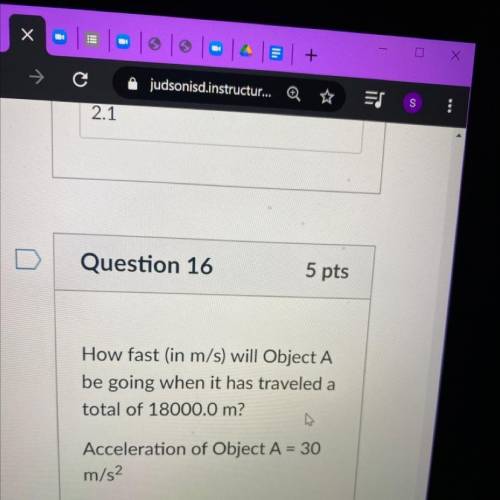How fast (in m/s) will Object A
be going when it has traveled a
total of 18000.0 m?
Acc...

Physics, 04.03.2021 02:40 Randy11111
How fast (in m/s) will Object A
be going when it has traveled a
total of 18000.0 m?
Acceleration of Object A = 30
m/s2


Answers: 2


Other questions on the subject: Physics

Physics, 22.06.2019 04:30, angie249
The pressure increases by 1.0 x 104 n/m^2 for every meter of depth beneath the surface of the ocean. at what depth does the volume of a pyrex (bulk modulus 2.6 x 1010n/m^2) glass cube, 9.8 x 10^−2m on an edge at the ocean's surface, decrease by 7.5 x 10−10m^3? explain the formula beyond this point: p=1.0x10^4, b=2.6x10^10, l=9.8x10^−2, delta v=7.5x10^−10. at some point l needs to be cubed. why p is divided by delta v?
Answers: 2

Physics, 22.06.2019 11:50, kaylallangari2145
Amoving electron has kinetic energy k1. after a net amount of work w has been done on it, the electron is moving one-quarter as fast in the opposite direction. (a) find w in terms of k1. (b) does your answer depend on the final direction of the electron's motion?
Answers: 2

Physics, 22.06.2019 15:00, koranbutterton
Astudent throws a water balloon with speed v0 from a height h = 1.76 m at an angle θ = 21° above the horizontal toward a target on the ground. the target is located a horizontal distance d = 9.5 m from the student’s feet. assume that the balloon moves without air resistance. use a cartesian coordinate system with the origin at the balloon's initial position. (a) what is the position vector, rtarge t, that originates from the balloon's original position and terminates at the target? put this in terms of h and d, and represent it as a vector using i and j. (b) in terms of the variables in the problem, determine the time, t, after the launch it takes the balloon to reach the target. your answer should not include h. (c) create an expression for the balloon's vertical position as a function of time, y(t), in terms of t, vo, g, and θ. (d) determine the magnitude of the balloon's initial velocity, v0, in meters per second, by eliminating t from the previous two expressions.
Answers: 3

You know the right answer?
Questions in other subjects:



Mathematics, 03.12.2020 19:20





Biology, 03.12.2020 19:20

Mathematics, 03.12.2020 19:20



